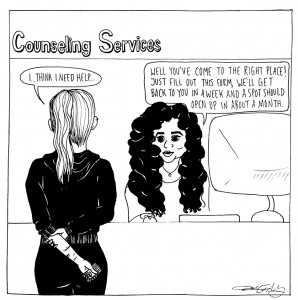For mental health, circumvent the health center altogether
The stress of USC’s academic rigor, the strains of fitting in without the comforting presence of old friends and the stark abandonment of the platitudes of a familiar high school life is something almost every Trojan can relate to. Unfortunately, this environment proves to be a breeding ground for the unyielding grips of debilitating anxiety and depression. The student in every four who experiences much more than gastric butterflies before a chemistry midterm must deal with a sickness that many prefer not to talk about. Though mental illness is the elephant in the room when it comes to today’s largest health challenges, it seems to be locked out of the room, waiting in line to get in. At USC, rather than seeking to address these challenges with band-aid solutions, we should create more rapid and efficient treatments for those with mental health issues by circumventing the Engemann Student Health Center altogether.
Some may argue that efforts targeted at eliminating the collegiate stigma, pioneered by many student organizations on campus, coupled with a marginal increase in counselors at the health center, is sufficient to strengthen mental health at USC. For example, organizations such as Free Minds, National Alliance on Mental Illness and Undergraduate Student Government work tirelessly to build a more accepting and tolerant campus for the mentally ill. This change only unlocks the door, however, allowing mental health to be part of the discussion. It still must wait behind other illnesses — labeled as more pressing — by the health center. Although the multitude of awareness programs have been a powerful tool, these initiatives only are effective in decreasing stigma and ignorance, rather than the source of the problem itself: the treatment of these disorders. Awareness alone will not help the forsaken student cooped up in Leavey, shivering from debilitating anxiety.
Unfortunately, the student previously illustrated is often deferred, and must wait behind many others due to the practice of triage at the health center, prioritizing some students with more pressing issues over others. According to Kelly Greco, a staff psychologist at the health center, the counselors at Engemann must first prioritize high-risk patients, whose lives may be at risk, before helping students deemed as low-risk, based on a 20-minute evaluation over the phone. The unfortunate side effect of this practice is that attending to a small demographic of students neglects the majority dealing with issues such as academic or social stresses, and prioritizes students with more grave complications. Of course, this practice is reasonable given the scarcity of counselors. Nevertheless, attending to those few students neglects the many who have made the undeniably brave leap of asking for help. By doing so, what starts as a simply academic or social problem could burgeon into a full-blown diagnosable illness, simply because a student did not have someone to talk to.
The health center’s administrative strategy of hiring more counselors will likely only lead to a marginal improvement in treatment. When I called the heath center, despite my previous diagnosis of bipolar disorder, I was put on a waiting list of two months in order to see a counselor, even after the new hires. Therefore, simply hiring more counselors will not eliminate this destructive waitlist. Hiring a sufficient amount of counselors would likely prove to be too costly for this large University. Rather, a more cost-effective alternative would be to create a complement to traditional counseling practices through peer-led, one-one-one counseling services.
Critics may say that placing such serious health concerns in the hands of undergraduate students could prove to be a liability for the University or even lead to improper identification or treatment of a serious condition. However, a student-led organization would not be liable to the same practice regulations that the accredited health center is subjected to. This lack of liability ensures that the University will not be fined for any malpractice committed by the organization and can benefit from the money the institution saves from this free counseling service. Moreover, this type of organization would not be a direct branch of the health center but an alternative advertised by professional counselors whom are equally distressed with the long list of people in need. In addition, the students would be trained directly by health center staff and would exclusively deal with the neglected population who are left to wait due to their designation as low-risk individuals. This form of peer counseling would serve as a buffer, providing students with a peer to serve as a sensitive listening ear, potentially preventing further harm.
One student initiative is pursuing this very strategy. Peer Counseling is the best bet for USC’s growing epidemic of long waiting lists and unaddressed mental health issues. This organization targets the neglected demographic that must wait months just for someone to listen to their distressed thoughts. Moreover, talking to a fellow peer, rather than a professional who may appear intimidating, may encourage the reluctant student who may not call the health center to seek help in the first place.
Even though USC has made strides to improve universal acceptance of mental disorders, there is still much room to grow and adapt to the increasing demand for counseling. An administrative approach — characterized by augmenting the number of counselors — has marginally improved a big and complex problem. Granted, putting this issue in the hands of the students may not resolve the ultimate issue of attending to each student in need. However, creating a safe environment for students to have a private conversation with a peer is a necessary step to creating a healthier Trojan Family.

